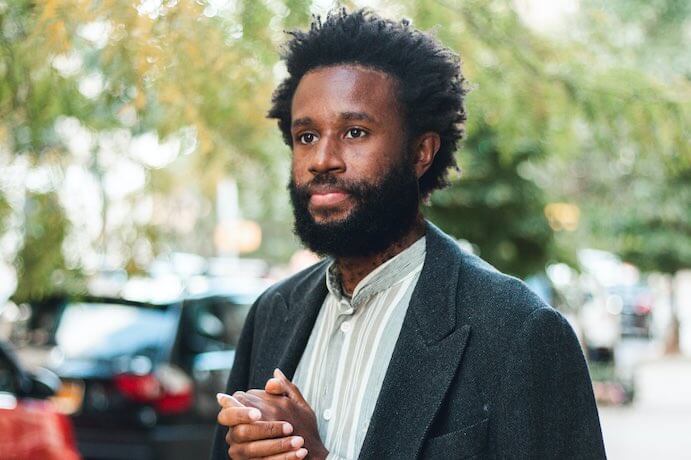For artist, writer and composer JJJJJerome Ellis, his name poses a challenge; not a challenge of identity per se, but a test of normativity. Ellis speaks with a stutter caused by a glottal stop. The outside perception of this disability is a mode of dysfluency characterized by long, breathless pauses, often in anticipation of known-to-be difficult words. “Dysfluency” is therefore a frequent term in the exposition of Ellis’ work.
Stylized as “JJJJJerome,” Ellis’ first name is the word he has the greatest difficulty speaking. The elision of repeating J’s is, on the surface, a riff on the classic stutterer cliché; juh-juh-juh-juh-Jerome. Therein, Ellis has provided a clue as to what his name means to him, or perhaps more acutely, the personal revelation he has been able to extract from the struggle it presents. This orthographic expansion of his name illustrates the passage of time on a personal scale. Where some may interpret a beat of silence in a conversation as a pause or delay, for Ellis, a journey is progressing within an expanding, temporal space. He calls this space “the Clearing.” Having chosen this phrase as the title of his forthcoming double album (dropping November 5, 2021 on NNA Tapes), Ellis has extended an invitation to commune with him in the Clearing to explore the ways in which we occupy and negotiate the passage of time.

While the notion of delay and prolonged silence are pervasive themes in Ellis’ work, when we spoke, I was challenged by the rapid ecstasy with which he cited the writers, artists, and musicians who inspire him, seemingly without pause. He referred to the works of W.E.B. DuBois, Sun Ra, Anthony Braxton, Brittney Cooper, Toni Morrison, and praised Joshua St. Pierre (a professor at the University of Alberta whose research focuses on stuttering) as a major influence.
Words are a central pillar in Ellis’ examination of his interactions with the world, or rather, how the world interacts with him as “a blk [sic] disabled animal, stutterer, and artist.” The most luminous dimension of Ellis’ perspective is how the nature of disability and the ways in which capability is measured and assigned distills into the experience of Blackness and Black artists in America. There remains, as he recently told me, a necessity “to perform [both] whiteness and fluency in order to survive.”
This examination is not limited to the difficulty Ellis faces in aligning with normative speech patterns, but to the depth and complexity of expressing meaning in relatable — if not normative — terms. In the opening few lines of the 128-page book that accompanies the album, Ellis divides the word “clearing” into an array of possible implications:
Does the bell’s ringing reach the forest and its clearings, site of resistant black oralities for centuries? The enslaved gathered in the woods at night to plan escapes and revolts, to dance, sing and pray. But the clearing is also the act of clearing native plants and Native peoples. What dwells between noun and verb here?
“The Clearing is a place to hide from the master, but it is also a place for planning revolt, liberation,” Ellis told me. He describes the Clearing as a meeting place where we can feel safe to discuss these things, noting that we were in the Clearing together at that moment in our conversation.
Much of Ellis’ current thought process is summarized in his 2019 essay The clearing: Music, dysfluency, Blackness and time. The Clearing began to take shape as a multimedia album at the top of 2020 when he was invited to participate in the 46th Annual New Year’s Day Marathon at The Poetry Project, based at St. Mark’s Church-in-the-Bowery in New York City.
Kyle Dacuyan, Executive Director of The Poetry Project, told me that collaborating with Ellis revealed “new ways to consider how a performance might exist as a temporal object.” The refinement of this concept came about once Ellis had accepted Dacuyan’s invitation to perform at the Marathon, provided it was understood that — due to his disability — the imposition of a time limit was ableist and exclusionary.
This point was a revelation to Dacuyan, who related to me his embarrassment at having overlooked the need for this type of accessibility in the program’s format. Fittingly, Ellis’ performance utilized pieces of his conversation with Dacuyan regarding time, objectivity, and the nature of his disability.
From this starting point, The Poetry Project commissioned Ellis to develop The Clearing into a multi-faceted project, which includes recorded telephone conversations, anecdotes that examine the peculiarities of communication with and without signalling one’s disability in advance, and excerpts from his 2019 essay. Layers of speech combine with a stylish conglomerate of musical forms ranging from trap-house beats to jazz inspired saxophone licks and electronics. Each is an exploration of various facets of Black identity that intersect uniquely with the nature of Ellis’ disability. As he writes in the accompanying book:
Thesis: I compose and play music to honour this act of gathering in the present. In music I can approach this gathering in ways I can’t through speech. Through my music I imagine a different way to approach the present. I imagine other presents (and pasts and futures). I seek to provide for others what stuttering so generously provides for me.
For the creation of the recording and two-disc vinyl album, The Poetry Project partnered with Brooklyn-based label NNA Tapes. The accompanying soft-cover book was created by independent publisher Wendy’s Subway, based in Bushwick. Rachel Valinsky, Artistic Director of Wendy’s Subway, had seen Ellis’ New Year’s Day performance and was excited by how well his work aligned with the publisher’s “document series.” This program seeks collaborations with artists (only recently including composers) whose work is time-based. Where the recording is an expanded setting of Ellis’ New Year’s Day performance, the book is a transmutation of the recording into a new, temporal space; as Valinsky described it to me, “a unique object in time.”
A system of notation was adapted from Ellis’ writings in collaboration with designer Rissa Hochberger. Each page represents a period of sixty seconds, upon which Ellis’ recorded performance is transliterated. The repetition of characters (as in JJJJJerome) serves as a measurement of the approximate time it takes Ellis to execute certain words.
I told Valinsky that as a musician, my personal presumption was to think of the book as a musical score to follow in parallel with the recording, at which point she interjected and said, “I actually prefer to think of the recording as the score for the book.” She went on to explain that the New Year’s Marathon performance was a setting of JJJJJerome’s essay, the album is a setting of the Marathon, and the book is a setting of the album.
When reading Ellis’ manuscript, there is an impulse to dart across long threads of repeated characters in search of recognizable words. But, those threads are the words, and their emphasis on the page serves only to enhance their meaning as the reader is moved to align with Ellis’ experience in forming them. This is how we find, as Ellis puts it, “a space for possibility rather than a pathology.” This is where we will find the Clearing.
I CARE IF YOU LISTEN is an editorially-independent program of the American Composers Forum, funded with generous donor and institutional support. Opinions expressed are solely those of the author and may not represent the views of ICIYL or ACF.
A gift to ACF helps support the work of ICIYL. For more on ACF, visit the “At ACF” section or composersforum.org.
























